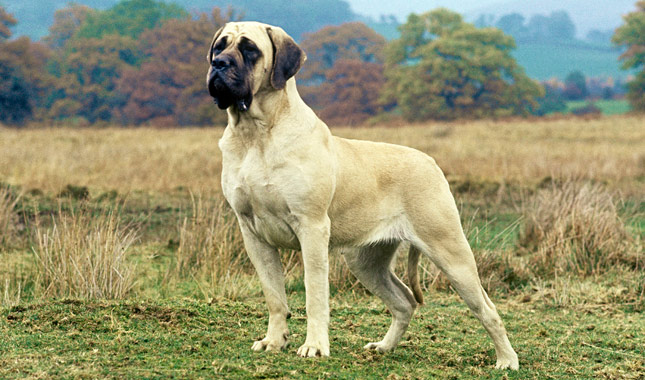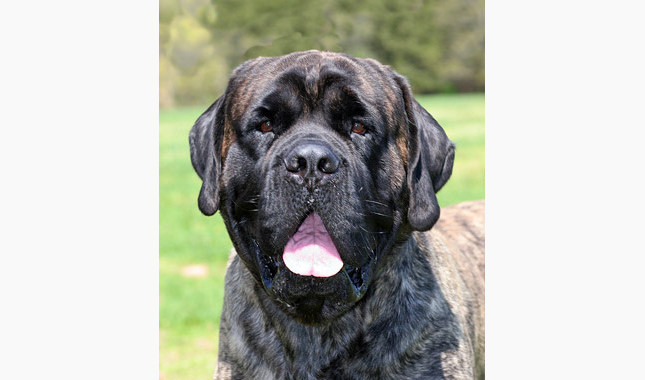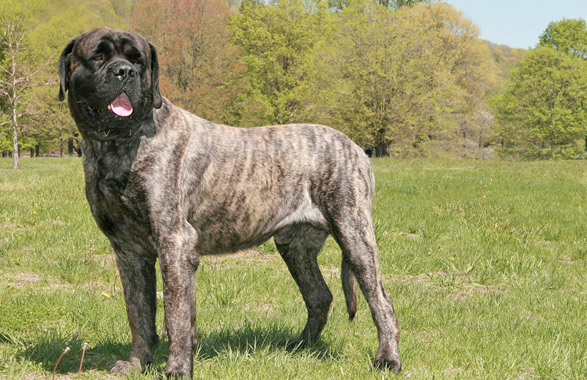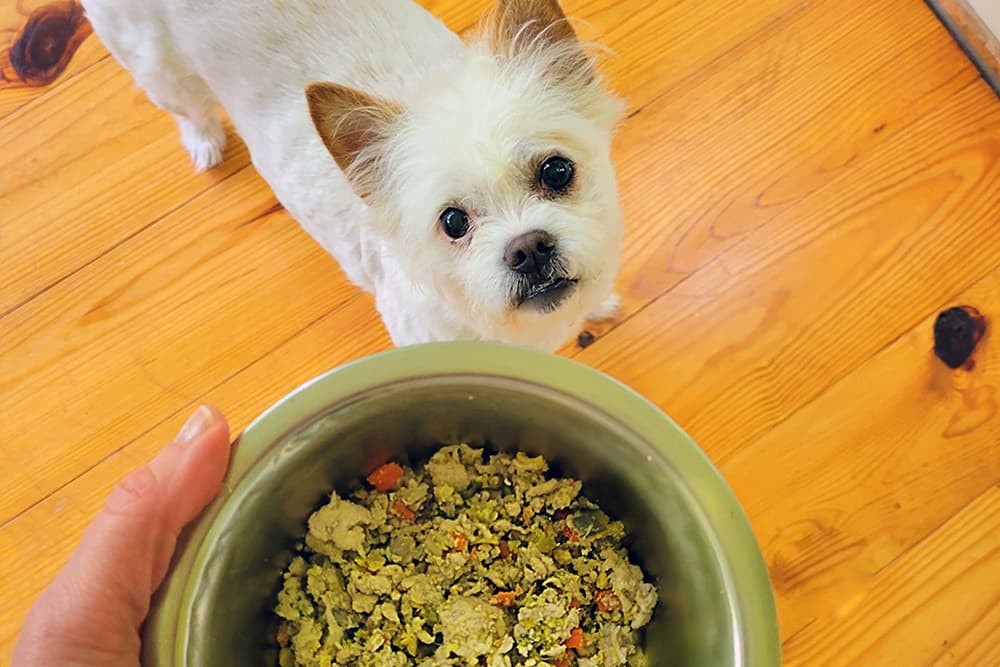Mastiff
Published on June 26, 2011
Breed Details
- Height: 27.5 to 30 inches or more at the shoulder
- Weight: 120 to 230 pounds
Breed Characteristics
Adaptability
Trainability
Grooming
Apartament Friendly
Child Friendly
Shedding Level
Dog Friendly
Exercise Needs
Territorial
Barking Tendencies
Health Issues
Social Needs
Energy Level
Affectionate
Watchdog Instincts
Cat Friendly
Intelligence
Stranger Friendly
The Mastiff is the classic gentle giant, loving but sometimes stubborn. His size alone is enough to deter troublemakers. At heart, he is a peaceful dog, but he is always protective of his family and will step in if danger threatens.With his imposing size, sleek coat, and distinctive black-masked face, the Mastiff — sometimes called the English Mastiff or Old English Mastiff — is probably not the dog you think he is. Certainly he’s the largest of the dog breeds, not the tallest but the heaviest, routinely weighing in at more than 200 pounds.
Mastiffs are known as “gentle giants,” big dogs whose main weapons are their size, reputation, and instinctive understanding of what is and isn’t a threat. A well-bred, well-socialized Mastiff will protect his human family as part of his nature, without any special training beyond simply making him a well-behaved member of the family.
If you’re physically up to the challenge of an extremely powerful dog who probably outweighs you, who is gentle and loving but has a definite stubborn streak (and that’s not a euphemism for aggression; the Mastiff is typically more selectively deaf than defiant), and don’t mind a certain amount of slobber, then the Mastiff may be your ideal dog.
If you want to leave him tied up in the backyard to protect your home, or view him as a status symbol because of his size or image, then he’s definitely not the dog for you. A Mastiff’s protective nature won’t assert itself on behalf of an arbitrary property line nor in defense of a few bricks and boards; it’s his family he protects, and that means you need to make him part of yours. Leave him in the yard all the time, and all you’ll get are some spectacular holes in the lawn and a bored, lonely, sad, and destructive dog whose potential is being completely ignored.
When it comes to everyday considerations, the Mastiff is easy to live with. He’ll certainly alert you if someone comes to the door, but he’s mostly a quiet presence in the home. His short coat sheds, but brushing a couple of times a week will help keep it under control. And while he does slobber, he’s not a world-class slobberer, and it can mostly be handled with a quick wipe after he’s eaten or had a drink of water. Still, if you’re totally against dog slobber, don’t get a Mastiff.
Obedience training needs to be consistent and fair, and must begin when your dog is a puppy, before bad habits have a chance to take hold. In particular you need to teach your Mastiff not to pull on the leash or jump on people, or he’ll be a hazard to anyone he’s around when he’s full-grown. Mastiffs are easy to housetrain if you show them where you want them to go and give them consistent opportunities to eliminate outdoors.
The key to developing proper Mastiff temperament as an adult is to socialize him around all kinds of people when he’s young. Far from making him less protective, it will make him more effective as a protector. He’ll know all the “right” body language that tells him someone is a friend. He’ll be familiar with how children, the elderly, kids on bikes, and skateboarders look, move, and sound, and he’ll use that information to pick out those with bad intentions all the more readily.
Speaking of children, Mastiffs usually love them and treat them with instinctive care, but the reality of a dog this big is that he can unwittingly hurt or scare a child. Be cautious and always supervise dogs and kids when they’re together. If you have toddlers, consider waiting until they’re older to bring a Mastiff into your family.
More Quick Facts
- Mastiffs are an old breed, once used as war dogs and to guard estates. These days, they are lovers, not fighters, but they will always protect their family.
- Mastiffs are flatulent and can clear a room fast when they pass gas.
- Breeders often like to keep Mastiff puppies until they are at least 12 weeks old to ensure that they are mature enough to go to their new homes.
- Mastiffs can adapt well to apartment or condo living, but if you have stairs, think about how you would get the dog in and out if he were old or incapacitated and couldn’t manage them on his own.
- Don’t overfeed your Mastiff puppy. He will still attain his genetically programmed size if you keep him at a healthy, lean weight during puppyhood.
The History of Mastiffs
The ancestors of the Mastiff probably originated in the mountains of Central Asia several thousand years ago. The name Mastiff probably comes from the Latin, either “massivus,” meaning huge, or “mastinus,” meaning house dog. The early Mastiffs were called molossers and were used for hunting, guarding and fighting. From Tibet or northern India they accompanied traders and nomads throughout the world, making their way to the Middle East, the Mediterranean, China and Russia. Ancient Egyptians depicted massive dogs on the walls of the pyramids, and in Greek mythology the three-headed canine guardian of the underworld is a mastiff-type dog. Greeks, Romans and other peoples all used mastiffs in battle.
In medieval times, Mastiffs patrolled estates at night, ever on the alert for poachers or other intruders. Through the 16th century they were still used as war dogs in Europe. One famous line of English Mastiffs descends from a female Mastiff belonging to Sir Piers Legh of Lyme Hall, who was injured at the battle of Agincourt in France in 1415. She guarded him until he could be removed from the field and cared for and was later returned to his estate in England. The Lyme Hall line of Mastiffs lasted into the 20th century.
Mastiffs as we know them today began to be developed in England in 1835. That was the same year that dogfighting was outlawed, making it a turning point in the breed’s temperament. If Mastiffs were to survive, they needed to have a more peaceful nature. The breed continued developing through the end of the 19th century, but World War I, with its food shortages, almost led to the demise of the Mastiff. The same thing happened during World War II. Fortunately, the breed was rebuilt and is moderately popular today.
The American Kennel Club recognized the Mastiff in 1885. The Mastiff ranks 28th in AKC registrations, up from 39th in 2000, showing a steady increase in popularity.
Mastiff Temperament and Personality
The calm and gentle Mastiff looks dignified at first glance, but beneath that noble expression lies a strong sense of humor just waiting to come out. He is affectionate with his family and always wants to be with them, but he doesn’t constantly demand attention. It’s enough for him to lie by their feet, lean against them and follow them from room to room, always there to make sure everyone is safe. If given half a chance, your Mastiff will snuggle with you on the sofa, doing his best imitation of a lap dog.
Mastiffs are gentle with children and other animals, wanting only to take care of them. They are famous for having a “soft mouth,” or the ability to carry things like kittens and squirrels without damaging them.
Just because he’s gentle doesn’t mean the Mastiff isn’t protective and territorial. He barks — a big, deep, scary bark — when strangers approach and doesn’t let up his guard until he has been introduced to the person and assured that he or she is welcome. Mastiffs aren’t attack dogs, but they very effectively prevent intruders from entering the premises or, if they have gotten in, from leaving again until the proper authorities arrive.
Mastiffs have moderate exercise needs. A sedate walk will satisfy them, but if you want to compete with them in obedience, rally or weight-pulling, they’re up for that, too.
Mastiffs dislike change, so if you’re planning to bring one into your life, make sure it’s what you really want. A Mastiff will bond closely to you and grieve if you give him up to another home or a shelter.
The perfect Mastiff doesn’t come ready-made from the breeder. Any dog, no matter how nice, can develop obnoxious levels of barking, digging, countersurfing and other undesirable behaviors if he is bored, untrained or unsupervised. And any dog can be a trial to live with during adolescence. In the case of the Mastiff, the “teen” years can start at nine months and continue until the dog is about two years old. Fortunately, Mastiffs are sensitive, smart and want only to please. That gives you a head start in training them, especially if you start early.
Start training your Mastiff puppy the day you bring him home. Even at three months old, he is capable of soaking up everything you can teach him. Never wait until he is six months old to begin training, or you will have a much bigger, more headstrong dog to deal with. A young Mastiff will test you to see what he can get away with. If possible, get him to puppy kindergarten class by the time he is 10 to 12 weeks old, so you can start building a strong working relationship and socialize, socialize, socialize. Shyness can be a problem in Mastiffs, so do your best to prevent it. However, be aware that many puppy training classes require certain vaccines (like kennel cough) to be up to date, and many veterinarians recommend limited exposure to other dogs and public places until puppy vaccines (including rabies, distemper and parvovirus) have been completed. In lieu of formal training, you can begin training your puppy at home and socializing him among family and friends until puppy vaccines are completed.
Talk to the breeder, describe exactly what you’re looking for in a dog, and ask for assistance in selecting a puppy. Breeders see the puppies daily and can make uncannily accurate recommendations once they know something about your lifestyle and personality.
The perfect Mastiff doesn’t spring fully formed from the whelping box. He’s a product of his background and breeding. Whatever you want from a Mastiff, look for one whose parents have nice personalities and who has been well socialized from early puppyhood.
What You Need to Know About Mastiff Health
All dogs have the potential to develop genetic health problems, just as all people have the potential to inherit a particular disease. Run, don’t walk, from any breeder who does not offer a health guarantee on puppies, who tells you that the breed is 100 percent healthy and has no known problems, or who tells you that her puppies are isolated from the main part of the household for health reasons. A reputable breeder will be honest and open about health problems in the breed and the incidence with which they occur in her lines.
The Mastiff can develop certain health problems. Here’s a brief rundown on a few of the conditions you should know about.
As might be predicted, given their large size, Mastiffs suffer from a number of joint and structural problems. It’s important that young, growing Mastiffs be kept lean and not allowed to exercise too strenuously or eat too much, as this will lead to injuries and problems that can be crippling down the road. In fact, all Mastiffs need to be kept lean, as obesity increases the chances they’ll develop certain structural problems and makes them more painful when they occur.
One such structural problem is the genetic hip deformity known as hip dysplasia. The head of the thigh bone doesn’t fit properly into the hip socket, and over time the cartilage and underlying bone suffer damage, leading to arthritis. Depending on severity, surgery may be needed to help prevent a lifetime of pain and lameness. Elbow dysplasia is a similar condition affecting the elbows. Mastiffs are also prone to cruciate ligament injuries in their knees.
It’s impossible to confirm a diagnosis of hip or elbow dysplasia simply from examining a dog or watching him move. Nor can hip and elbow dysplasia be ruled out entirely just because the parents were free of the condition, although it reduces the risk.
The Mastiff is at risk for a number of heart conditions, including cardiomyopathy, pulmonic stenosis, mitral dysplasia, and subaortic stenosis. Regular heart exams can increase the chances of catching these conditions early. Dogs with any of these conditions should not be bred, nor should any Mastiff be bred without first passing a comprehensive heart examination by a board-certified veterinary cardiologist and having OFA certification within the previous year. The sad reality, however, is that a puppy of two parents without heart disease can still develop it.
The Mastiff can be affected by a very long list of eye diseases, incluiding entropion and ectropion (eyelid deformities), progressive retinal atrophy, corneal dystrophy, and retinal dysplasia.
Mastiffs are also more likely than many breeds to bloat, a condition in which the stomach distends with gas and can twist on itself (called gastric torsion), cutting off blood flow. Bloat and torsion strikes very suddenly, and a dog who was fine one minute can be dead a few hours later. Watch for symptoms like restlessness and pacing, drooling, pale gums, lip licking, trying unsuccessfully to vomit, and signs of pain. Bloat requires immediate veterinary intervention, and surgery is necessary in many cases. Unfortunately, dogs that have bloated can bloat again, so most veterinarians offer a procedure known as gastropexy or “stomach tacking,” which anchors the stomach to the body wall to help keep it from twisting in the future. This procedure can also be done as a preventive measure.
Cystinuria is a genetic kidney defect that leads to the formation of bladder stones that are difficult to manage with diet or medication. The dog often requires surgery both to remove the stones from the bladder and to repair urinary blockages. There may be no advance signs that the dog is forming cystine stones, but urinary blockage is a life-threatening veterinary emergency. Unfortunately, the current screening test for cystinuria is of limited use, as it can yield false negative or (occastionally) false positive results. The mode of inheritance of cystinuria in Mastiffs is not completely understood and there is no genetic screening test, so it’s impossible to determine if a dog is a carrier or not.
Cancer, including lymphosarcoma, is also a concern in the breed. No screening tests are available for this problem, which may not occur until later in life, but you can ask the breeder what problems he has seen in his lines.
Not all of these conditions are detectable in a growing puppy, and it can be hard to predict whether an animal will be free of these maladies, which is why you must find a reputable breeder who is committed to breeding the healthiest animals possible. They should be able to produce independent certification that the parents of the dog (and grandparents, etc.) have been screened for genetic defects and deemed healthy for breeding. That’s where health registries come in.
The Mastiff Club of America participates in the Canine Health Information Center, a health database. Before individual Mastiffs can be issued a CHIC number, breeders must submit hip, elbow and heart evaluations from the Orthopedic Foundation for Animals (OFA) and eye test results from the Canine Eye Registration Foundation (CERF). PennHip certification of hips is also accepted. Optional CHIC test results that can be submitted are OFA certification of thyroid health (the breed is prone to hypothyroidism), and the results of at least one normal urine test for cystinuria, done by the University of Pennsylvania.
Breeders must agree to have all test results, positive or negative, published in the CHIC database. A dog need not receive good or even passing scores on the evaluations to obtain a CHIC number, so CHIC registration alone is not proof of soundness or absence of disease, but all test results are posted on the CHIC website and can be accessed by anyone who wants to check the health of a puppy’s parents. If the breeder tells you she doesn’t need to do those tests because she’s never had problems in her lines and her dogs have been “vet checked,” then you should go find a breeder who is more rigorous about genetic testing.
Careful breeders screen their breeding dogs for genetic disease and breed only the healthiest and best-looking specimens, but sometimes Mother Nature has other ideas and a puppy develops one of these diseases despite good breeding practices. Advances in veterinary medicine mean that in most cases the dogs can still live a good life. If you’re getting a puppy, ask the breeder about the ages of the dogs in her lines and what they died of.
Remember that after you’ve taken a new puppy into your home, you have the power to protect him from one of the most common health problems: obesity. Keeping a Mastiff at an appropriate weight is one of the easiest ways to extend his life. Make the most of your preventive abilities to help ensure a healthier dog for life.
The Basics of Mastiff Grooming
The Mastiff’s short coat is easy to care for. Brush it with a rubber curry brush at least weekly — daily, if you want. The brush removes dead hairs that would otherwise end up on your floor, furniture and clothing.
Mastiffs shed moderately to heavily. Some dogs shed heavily only during spring and fall shedding seasons, while others consistently shed throughout the year. The more you brush, the less hair you’ll have flying around.
To keep your Mastiff’s facial wrinkles clean and infection-free, wipe them out as needed (either daily or weekly) using a damp cloth or a baby wipe. Then dry them thoroughly. Moisture left behind can create the perfect environment for bacterial growth.
Bathe your Mastiff only when he’s dirty. If you’re lucky, that won’t be very often. But if you want to bathe him every week, you can. Just use a gentle shampoo made for dogs.
The rest is basic care. Trim his nails as needed, usually every week or two, and brush his teeth with a vet-approved pet toothpaste for good overall health and fresh breath.
Finding a Mastiff
Whether you want to go with a breeder or get your dog from a shelter or rescue, here are some things to keep in mind.
Choosing a Mastiff Breeder
Finding a good breeder is a great way to find the right puppy. A good breeder will match you with the right puppy, and will without question have done all the health certifications necessary to screen out health problems as much as is possible. He or she is more interested in placing pups in the right homes than in making big bucks.
Good breeders will welcome your questions about temperament, health clearances and what the dogs are like to live with and come right back at you with questions of their own about what you’re looking for in a dog and what kind of life you can provide for him. A good breeder can tell you about the history of the breed, explain why one puppy is considered pet quality while another is not, and discuss what health problems affect the breed and the steps she takes take to avoid those problems.
Start your search for a good breeder at the website of the Mastiff Club of America, and locate a breeder who has agreed to abide by its code of ethics, which prohibits the sale of puppies to or through pet stores and calls for the breeder to take back any dog during its life if the owner is unable to keep him. Choose a breeder who is not only willing but insists on being a resource in helping you train and care for your new dog.
Ask the breeder to show you the results of genetic health testing. All breeders should be able to show written documentation from the Orthopedic Foundation for Animals (OFA) and the Canine Eye Registration Foundation (CERF) clearing your puppy’s parents of hip and elbow dysplasia, heart disease, and eye problems. PennHip certification of hips is also accepted. Ideally they will also have OFA certification of thyroid health, and the results of at least one normal urine test for cystinuria, done by the University of Pennsylvania.
Pay close attention to your potential puppy’s temperament. While most Mastiffs do have good temperaments, because of their size, a breeder who has American Temperament Test Society (TT) certification on her dogs is to be preferred over one who does not.
Avoid breeders who only seem interested in how quickly they can unload a puppy on you and whether your credit card will go through. Breeders who offer puppies at one price “with papers” and at a lower price “without papers” are unethical and should be reported to the American Kennel Club. You should also bear in mind that buying a puppy from websites that offer to ship your dog to you immediately can be a risky venture, as it leaves you no recourse if what you get isn’t exactly what you expected. Put at least as much effort into researching your puppy as you would into choosing a new car or expensive appliance. It will save you money in the long run.
Many reputable breeders have websites, so how can you tell who’s good and who’s not? Red flags include puppies always being available, multiple litters on the premises, having your choice of any puppy, and the ability to pay online with a credit card. Those things are convenient, but they are almost never associated with reputable breeders.
Whether you’re planning to get your new best friend from a breeder, a pet store, or another source, don’t forget that old adage “let the buyer beware”. Disreputable breeders and facilities that deal with puppy mills can be hard to distinguish from reliable operations. There’s no 100% guaranteed way to make sure you’ll never purchase a sick puppy, but researching the breed (so you know what to expect), checking out the facility (to identify unhealthy conditions or sick animals), and asking the right questions can reduce the chances of heading into a disastrous situation. And don’t forget to ask your veterinarian, who can often refer you to a reputable breeder, breed rescue organization, or other reliable source for healthy puppies.
The cost of a Mastiff puppy varies depending on his place of origin, whether he is male or female, what titles his parents have, and whether he is best suited for the show ring or a pet home. Expect to pay $1,500 or more for a puppy. The puppy you buy should have been raised in a clean home environment, from parents with health clearances and conformation (show) and, ideally, working titles to prove that they are good specimens of the breed. Puppies should be temperament tested, vetted, dewormed, and socialized to give them a healthy, confident start in life.
Before you decide to buy a puppy, consider whether an adult Mastiff might better suit your needs and lifestyle. Puppies are loads of fun, but they require a lot of time and effort before they grow up to become the dog of your dreams. An adult Mastiff may already have some training and will probably be less active, destructive and demanding than a puppy. With an adult, you know more about what you’re getting in terms of personality and health and you can find adults through breeders or shelters. If you are interested in acquiring an older dog through breeders, ask them about purchasing a retired show dog or if they know of an adult dog who needs a new home. If you want to adopt a dog, read the advice below on how to do that.
Adopting a Dog From a Mastiff Rescue or Shelter
There are many great options available if you want to adopt a dog from an animal shelter or breed rescue organization. Here is how to get started.
1. Use the Web
Sites like Petfinder.com and Adopt-a-Pet.com can have you searching for a Mastiff in your area in no time flat. The site allows you to be very specific in your requests (housetraining status, for example) or very general (all the Mastiffs available on Petfinder across the country). AnimalShelter.org can help you find animal rescue groups in your area. Also some local newspapers have “pets looking for homes” sections you can review.
Social media is another great way to find a dog. Post on your Facebook page that you are looking for a specific breed so that your entire community can be your eyes and ears.
2. Reach Out to Local Experts
Start talking with all the pet pros in your area about your desire for a Mastiff. That includes vets, dog walkers, and groomers. When someone has to make the tough decision to give up a dog, that person will often ask her own trusted network for recommendations.
3. Talk to Breed Rescue
Networking can help you find a dog that may be the perfect companion for your family. Most people who love Mastiffs love all Mastiffs. That’s why breed clubs have rescue organizations devoted to taking care of homeless dogs. The Mastiff Club of America’s rescue network can help you find a dog that may be the perfect companion for your family. You can also search online for other Mastiff rescues in your area.
The great thing about breed rescue groups is that they tend to be very upfront about any health conditions the dogs may have and are a valuable resource for advice. They also often offer fostering opportunities so, with training, you could bring a Mastiff home with you to see what the experience is like.
4. Key Questions to Ask
You now know the things to discuss with a breeder, but there are also questions you should discuss with shelter or rescue group staff or volunteers before you bring home a pup. These include:
What is his energy level?
How is he around other animals?
How does he respond to shelter workers, visitors, and children?
What is his personality like?
What is his age?
Is he housetrained?
Has he ever bitten or hurt anyone that they know of?
Are there any known health issues?
Wherever you acquire your Mastiff, make sure you have a good contract with the seller, shelter or rescue group that spells out responsibilities on both sides. Petfinder offers an Adopters Bill of Rights that helps you understand what you can consider normal and appropriate when you get a dog from a shelter. In states with “puppy lemon laws,” be sure you and the person you get the dog from both understand your rights and recourses.
Puppy or adult, take your Mastiff to your veterinarian soon after adoption. Your veterinarian will be able to spot problems, and will work with you to set up a preventive regimen that will help you avoid many health issue













